When it comes to bugs, summer is one of the worst times. From midges and gnats to mosquitos and June bugs, bugs seem intent on causing you misery throughout the summer, and sweat bees are the same. From using your skin as a runway to circling around your face or gate crashing at your garden party. I mean, what is up with these creatures? Why are sweat bees so attracted to us? And do sweat bees pose a danger? Keep reading and find out how to get rid of sweat bees.
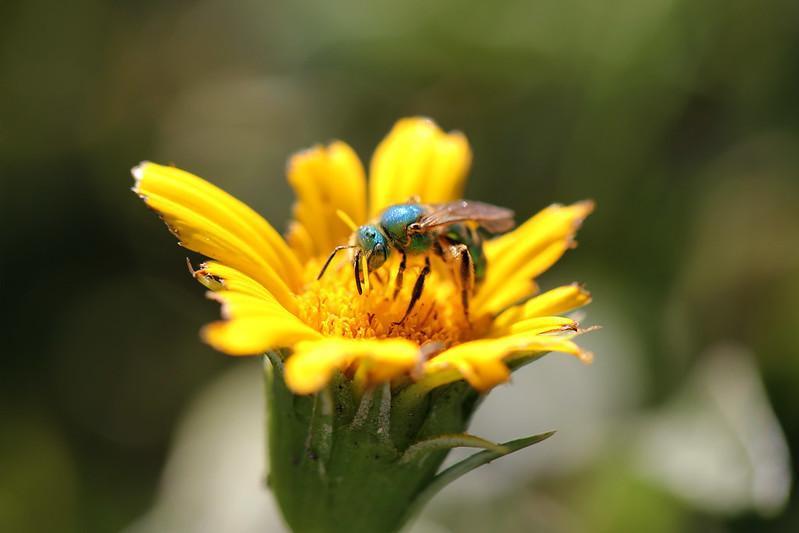
Sweat bees are often called “sweat bees,” particularly the smaller species, as they are attracted to human sweat.
Sweat bees have a particular fondness for salt, which explains why they are so attracted to your sweating skin. However, sweat bees are not dangerous to humans, even though they can be pretty annoying, especially when congregated in huge numbers. Furthermore, getting rid of them is quite straightforward. Just use some sort of insect repellant, limit how much skin you expose, and get rid of old branches and logs from around your home, and they will be gone as darkness at dawn.
So, let’s take a more in-depth look at these insects so that you will know how to eliminate them and stop them from spoiling your summer fun.
Let’s Start With …What Exactly Are Sweat Bees?

The term “sweat bee” refers to a diverse group of insects, some of which are pivotal as pollinators.
While you may have dealt with these tiny annoying insects, you might not know much about them.
For example, only a few people know that sweat bees are scientifically known as halictid bees, and they are members of the bee family Halictidae. And even fewer know that this is the most widespread bee family in the world after honey bees.
As already stated, sweat bees get their name from their insatiable appetite for human sweat or, more specifically, the salt (sodium) in human sweat. It only takes a whiff of human sweat for these bees to make their way under clothing and into the hair.
Similar to how athletes require more protein to meet their exercise goals, sweat bees need the salt in sweat to support their more active lifestyle. But the good news is that sweat bees have one of the least painful stings of all the bees.
Here is some more information on sweat bees and their behavior:
What Do Sweat Bees Look Like?
Since more than a thousand different species of sweat bees have been reported up until this point, it is very hard to describe them accurately.
However, the vast majority of species have a dull to metallic black color, with the remaining species being metallic green, blue, or purple. Sweat bees, with their metallic sheen, are often mistaken for blowflies or hoverflies.
However, many are not linked with bees in general since they do not have the typical yellow color of bees. Also, in comparison to other types of bees, sweat bees are pretty small. On average, they are no longer than half an inch in length.
Many people may not even notice their presence due to their diminutive stature. Regarding their shape, sweat bees are more or less slender, with the queen being a somewhat more rounded form and the male bees being more slender than the females.
RELATED: What are the Best Practices to Get Rid of Thrips on Houseplants?
Where Do Sweat Bees Live?
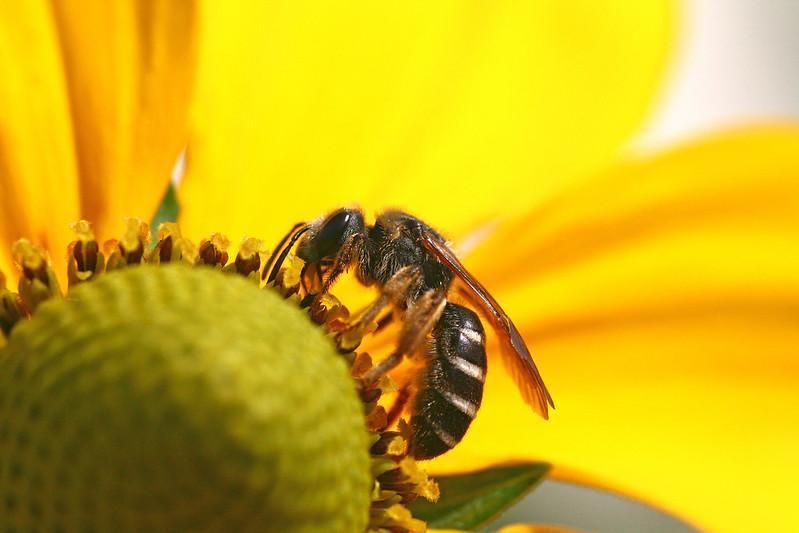
Sweat bees are often solitary and typically burrow holes in the soil to build their nests.
Even though sweat bees are widespread in temperate regions, you can find them all throughout the United States. For example, there are about a thousand species of sweat bees in the US, Canada, and Central America combined, with Florida alone having about 44 different species.
It is interesting to note here that sweat bees are the only species of bee that nest in the soil, and they typically dig their burrows in dry, sunny locations.
Sometimes, though, you may also find their nests in soft wood. Other than that, these bees usually spend their lives alone and are solitary. However, depending on the species, some are also highly social (eusocial). Nevertheless, in soil, the nests of sweat bees look like a network of tunnels with multiple entrances and exits.
However, since most of the nest is underground and therefore invisible, even so, you might still be able to easily spot a sweat bee nest by its opening as it looks very similar to anthill entrances. Moving on, sweat bees are commonly near human and animal populations as these insects are drawn to water and sweat.
So, it is highly likely that you will find these pesky bugs near a pool. Also, there are many of them in places with humid jungle weather, meadows, and orchards.
What Are The Behavioral Attributes Of Sweat Bees?
Sweat bees are commonly observed in swarms outside their nests but are rarely hostile. And even though they can be a nuisance at times, sweat bees play an essential role in the pollination of many plants, including stone fruits, alfalfa, and sunflowers.
In fact, sweat bees have a more sophisticated detoxification and gastrointestinal system than any other bees to handle and process the widely different types of pollen found in plants.
They are an absolutely essential component in the process of pollination for the native plants of the regions they inhabit, and they will literally pollinate any kind of flower that’s accessible. Talking about their interactions with humans, sweat bees are typically non-aggressive.
However, if cornered, they will sting, and just like the sting of other bees, their stings can readily set off allergic reactions. Also, if you don’t remove the stinger immediately, it will continue injecting venom into your skin, causing discomfort and pain.
However, compared to the stings of other bees, the stinger of sweat bees is rather bearable. Moving on, sweat bees are often active from March all the way until the end of the summer.
However, in some places, such as Georgia, the activity of sweat bees reaches its maximum between March and October.
Nevertheless, if you’ve noticed that there are a lot of these tiny bees this year, it’s because of the humid weather. Hot and humid conditions make people sweat, exposing the salt that attracts these sweat bees.
What Do Sweat Bees Eat?
Sweat bees feed on pollen and nectar from a wide range of common flowers during their foraging trips.
However, in order to survive, sweat bees also require salt, and they acquire their salt by feeding on human sweat. And since salt is scarce in nature, especially on the sweet nectar the sweat bees feed on; the sweat bee will lick the sweat from your skin.
It is just like how a deer occasionally licks salt or an athlete drinks an electrolyte drink. And if a sweat bee is hungry and attracted to you, it will keep flying around you looking for a place to land, which can be quite a nuisance.
Are Sweat Bees Dangerous?
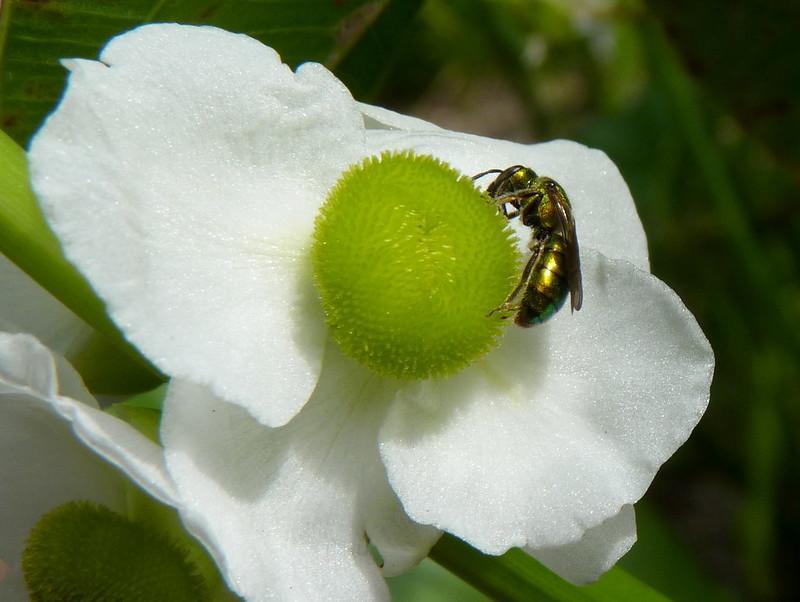
Sweat bees are not dangerous; they rarely sting, if ever, and people who are stung hardly ever report feeling any pain.
However, this pain is still there, and you will also need to look for any allergic reactions, just as you would with any other insect, bee sting, or bite.
However, since the term “sweat bee” refers to a great number of different species of “bees” (over 1,000 in North America alone), it is difficult to determine whether or not a person will have an allergic response to the sting of a particular sweat bee or how severe it will be.
Many bee stings occur when someone tries to swat or swipe a bee away from their skin. Therefore, if you find a sweat bee on your body, do not make any sudden movements.
Instead, wait for it to leave on its own. Also, getting stung by a sweat bee is quite rare because, in contrast to most other bees, sweat bees prefer to avoid conflict and refrain from stinging. Lastly, it is only the female sweat bees that sting. Females, huh?
How To Treat A Sweat Bee Sting?
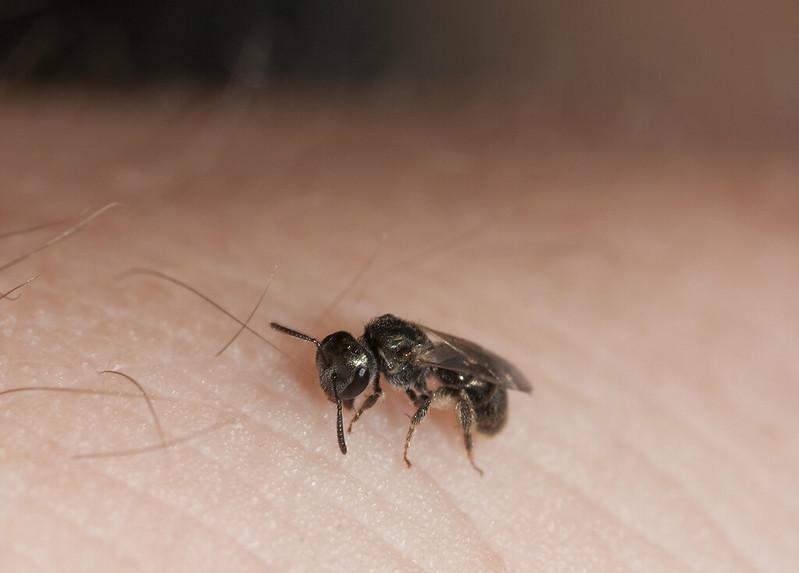
If a sweat bee stings you, try placing a cloth soaked in vinegar on the sting site to treat the sting.
Symptoms
There are two types of outcomes in the case of a sweat bee sting.
First, if you are not allergic to bee venom, you will only experience some localized, mild symptoms at the sting site, such as a white spot at the affected area, swelling or redness around the sting, itching, and pain or a stinging sensation.
On the other hand, if you have an allergy to bee stings, you might experience some very serious reactions. Also, even if you are not allergic to bee stings, you can have a severe reaction if you are stung multiple times in a row.
These reactions typically include but are not limited to diarrhea, dizziness, fainting, headache, nausea, stomach cramps, and vomiting.
Treatment
As far as the treatment is concerned, it depends on the severity of the allergic reaction.
For example, if the reaction is only mild, you can treat it at home. To do this, clean the affected area with soap and water and apply some ice cubes to reduce inflammation and swelling. Apply a topical analgesic if the pain persists.
In addition, you can apply a paste made of baking soda and water to the affected area in order to alleviate the pain, itching, and swelling.
Alternatively, just wet an aspirin tablet and apply it to the stung site. If, on the other hand, the swelling or pain reaches other parts of the body or you experience dizziness, difficulty breathing, or nausea, you should immediately go to the emergency room.
There, in addition to administering epinephrine injection, a physician may also provide you with other treatments for treating the allergic reactions and accompanying symptoms.
Should You Kill Sweat Bees?
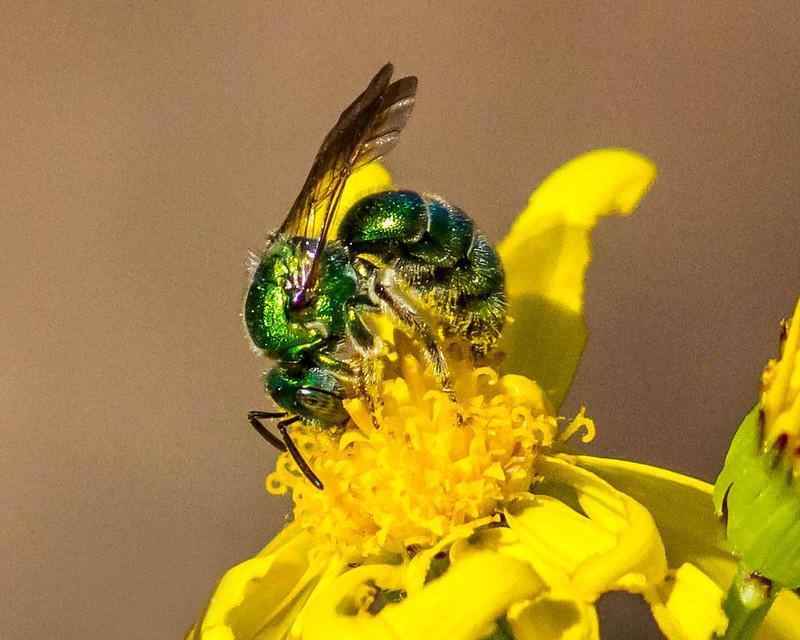
According to experts, killing sweat bees is usually not a good idea.
Even though sweat bees, their presence, and their ground nests can be pretty annoying, experts often do not recommend killing sweat bees. It is because these tiny bees are an integral part of our ecosystem, where they play a pivotal role in pollinating many types of plants, including crops and wildflowers you see every day.
However, if you are determined not to have sweat bees around you, there are ways in which you can remove their ground nests. The most straightforward and reliable is just to call an insect control service that will do the job for you.
However, if you want to do it on your own, read on. We have covered the topic in detail, and it will definitely help you get rid of sweat bees in and around your home and prevent them from coming back. Also, never use gasoline to get rid of sweat bees.
Many internet sites and people suggest using it to burn sweat bee nests, but gasoline is not good for the environment and poses a fire hazard on your property.
RELATED: White Fuzzy Jumping Bug on Plants: How to Get Rid of Them?
How To Keep Sweat Bees At Bay?
Sweat bees are essential pollinators; having them around will help your garden and flowers thrive. So what we are trying to say is that while you may want to get rid of some of them, you may want to keep them around as their pros far outweigh their cons.
Your best course of action is just to get them to leave on their own. However, getting rid of them can be pretty tricky as they will be naturally present where there are flowering plants and are extremely beneficial to the overall health of your garden.
Nevertheless, here are a few things you can do to drive them away:
Selective Planting
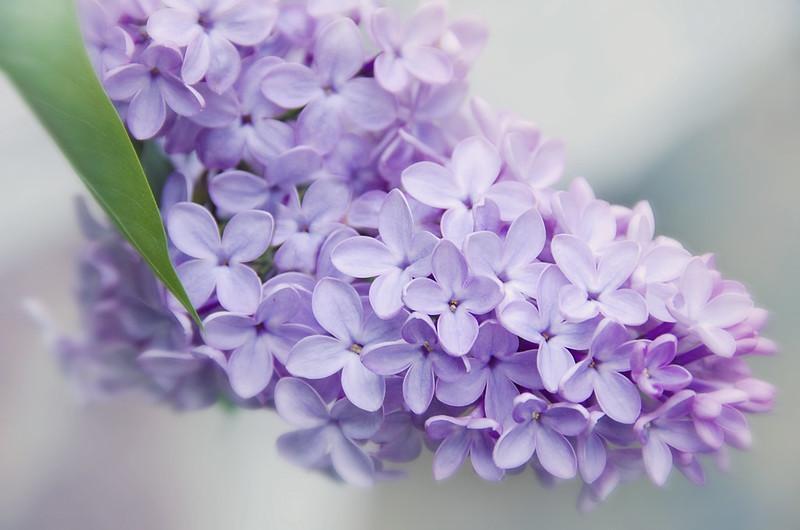
If you have lilacs growing in your yard, move them away to keep the sweat bees at bay.
Let’s start by talking about the plants that bees, including sweat bees and other common household insects, love. Some of them include Black-eyed Susan, Honeysuckle, Lantana, Lilac, Poppies, Sedums, Snapdragons, Sunflowers, and Wisteria.
These plants or the flowers that grow on these plants give off such scents that bees and insects adore. And, if you have them in your garden or backyard, they will definitely attract sweat bees too. Therefore, it will probably be a good idea to remove such plants from your garden or at least move them to a more distant location in your yard.
In addition, there are also some plants that you can use to repel bees and wasps away from your garden or backyard. These include Marigolds, Cucumbers, Eucalyptus, Mint, and Geraniums. Some of them have colors that bees cannot see.
Whereas others have scents that bees and other insects do not like. Also, just for fun, you can plant pitcher plants in your garden, which will definitely get the job of keeping sweat bees and, as a matter of fact, any other bees away from your home.
Mothballs
Do you ever just happen to have bought mothballs online at amazon or in a local store and do not know what to do with them? Well, you can use them to drive away sweat bees and, as a matter of fact, any other bees and creepy, pesky insects as well.
Mothballs have a smell that bees do not like, which drives them away. However, bear in mind that mothballs, while helpful, can be dangerous for humans. Therefore, use them with care. But all you have to really do is just hang them near a sweat bee nest.
Over time the smell from the mothballs will drive the sweat bees away and prevent them from coming back. Also, if you see sweat bees inside your home, you can hang them in places where they visit the most, and it will keep them away.
Expose Less Skin

Since sweat bees are drawn to sweating skin, covering it might help keep them away.
If the weather out in your garden is not particularly hot and if you are comfortable, try wearing shirts with long sleeves and full-length pants. This will discourage the bees from landing on your skin and stinging you in the first place.
Furthermore, this will prevent the scent of sweat from escaping your body out into the wind, which could attract more sweat bees. However, this approach will not always be practical, as sweat bees can even crawl under clothing.
Also, this will not work if you are at a pool side party. So, you will definitely have to resort to other methods of keeping sweat bees at bay. Some of these are:
Ensure Good Personal Hygiene
If you are a gardener and live in a hot and humid place, you will attract sweat bees while working a sweat on your precious plants. However, if you are ready to sacrifice on your diet a bit, you can reduce how many sweat bees you attract.
Remember why sweat bees are attracted to your sweat? It is because they are looking for salt or sodium. So, if you can eat foods that contain less of it, you will minimize the amount of salt in your sweat and, thus, the sweat bees you attract.
Essential Oils

Essential oils such as lemon oil can also help keep sweat bees at bay with their strong scent.
No matter what sort of problem you have, nature will always come to your rescue. It can also help you protect yourself and keep sweat bees at bay.
How? Well, that is where essential oils come in. Some of the most common examples include Citronella Oil, Citrus Oil, Clove Oil, Eucalyptus Oil, Lemon Oil, Peppermint Oil, and Rosemary Oil.
Take citrus oil, for example. It has tough, oily skin that smells pungent. So, when you squeeze the peel of a citrus (do not try it near someone’s eyes), essential oils will spray into the wind, and you could easily smell their scent or might even see the spray.
This thick rind and the pungent smell of essential oil it contains serve as a defense barrier to keep the seeds and tender flesh safe from the hungry insects and bees. And you can use this pungent smell to your advantage and keep sweat bees away.
To do this, take any essential oil listed above or any other one, dilute it with water, and then rub the concoction on your skin. You can even use this natural strategy to an even higher level and mix any essential oil of your liking into a make-at-home candle kit.
Then you can burn these candles in your home or at your dining tables outdoors to keep sweat bees away. Finally, you can simply just place essential oils in an oil burner and place them around your home. That way, you will not only drive sweat bees away but also enjoy a lovely aroma of your liking all day long when moving around in the home.
Sweat Bee Repellent
If the above methods do not work for you, you can also use sweat bee repellents. In fact, using sweat bee repellents is the most humane way to keep these insects at bay.
For repellent, you can use a universal repellent that not only keeps sweat bees away but is also effective against many other insects, including bees, June bugs, and mosquitos.
However, in my experience, Repellants based on dichlorvos are the most effective. These compounds have a short residual effect and are particularly effective at keeping sweat bees from hovering all over you during your fun outdoor time.
While you can make many repellent formulas at home using the essential oils mentioned above, the easiest and most straightforward approach is to buy an over-the-counter branded product at a local or online store such as amazon.
They usually come in the form of a spray, cream, or ointment and provide you with the comfort of just pulling out the bottle and applying the repellent to your skin.
Experts also recommend using repellents against sweat bees instead of exterminating them straight away because of their fundamental role in pollination. However, if you are still hooked on eradicating them altogether, the following methods are for you!
RELATED: What Is Eating My Plants At Night? Learn About The Evil Creatures Involved!
Ground Bee Insecticides

Bonide 363 Spider And Ground Bee Killer – 10 oz.
If you are just dead set on eradicating sweat bees from your home or backyard, you can always buy an over-the-counter ground bee insecticide spray. These products are specifically designed to kill ground bees, such as miner bees and sweat bees. Often these products come in powder and liquid forms that you can use directly.
However, some liquid ground bee insecticide sprays also come in concentrated solutions that need to be diluted before use. In the case of ground bees, such as sweat bees, these sprays often need to be diluted and then used as a spray.
Whereas the powder dust is applied directly around the opening of the nest.
So, when the bees come out of their nests, they come in contact with the insecticide and carry it to the inside of the nest, where it affects the queen.
Over time, the insecticidal properties of the powder kill the inhabitants.
Aerosol Bee Sprays
If sweat bees are a problem indoors, aerosol bee sprays are probably the best course of action to get rid of these pesky bugs. They are fast, easy to use, and highly effective against sweat bees for small localized applications indoors or inside the home.
My favorite is Spectracide Carpenter Bee & Ground-Nesting Yellow Jacket Killer Foaming Aerosol, which kills insects on contact. Its foam-based formula expands to reach where the insects live. All you have to do is spray, and you are good to go.
Sweat Bee Traps
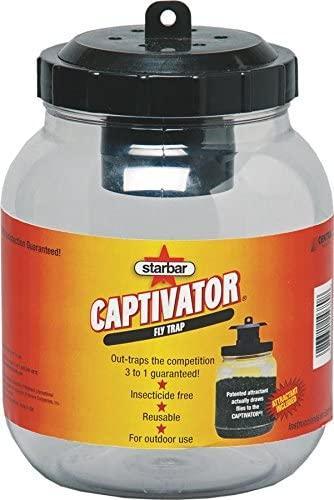
Farnam Home and Garden 14680 Starbar Captivator Fly Trap (1.06 ounces or 30 grams)
Another great way to permanently get rid of sweat bees or reduce their numbers in your surroundings is to use bee traps. These can be easily obtained from online stores such as amazon and local gardening and hardware stores.
Moreover, they are simple to use. All you have to do is place them near the nest, and a sugar solution placed inside them will lure the bees in.
These traps are designed with a funnel-shaped opening, and once bees are inside the container, they will not be able to and will eventually drown inside the sugar concentrate to their death.
The bait can also be made from nectar, soap, or any fragrant sugar substance that attracts sweat bees and other insects.
Take A Shower
Sometimes bees are also attracted to the fragrance of perfumes and body lotions. So, if you think that is the problem, try changing the product. Also, sweat bees are more likely to hang or hover around you if you are dressed in dirty, sweaty clothes.
So, if you are about to hang out in your backyard or garden, we recommend you shower and change your clothes, and sweat bees won’t bother you much.
Mulch & Till Your Soil
Sweat bees love to nest in dry sandy soils with little to no disturbance. However, they don’t really like much else. So, if you just sprinkle your backyard with some water and till the soil, the ground will become undesirable to sweat bees, and they will leave.
Furthermore, we highly recommend that you cover bare surfaces in your backyard with mulch so that bees have a tougher time nesting there.
Give Your Lawn Plenty of Water

If you water your soil frequently, bees will have difficulty nesting there.
Even though sweat bees love sweaty wet skin, they are not a big fan of damp soil full of moisture. So, we highly recommend that you water your lawn at least two times a day, and with any good luck, bees will get a hint and eventually leave.
You can also set up an automatic sprinkler system in your yard if you do not have time to water your lawn regularly to discourage the bees from visiting it.
Get Rid Of Debris
As already stated, sweat bees usually make their nests inside the soil where the ground is dry and remains relatively disturbance free. However, if such soil or ground is unavailable, sweat bees will also make their nest in soft or rotting wood.
Therefore, if you have any such thing lying around in your home, backyard, and garden …get rid of it. This will discourage bees from making nests there.
Grow Plenty Of Grass & Plants
Once again, since sweat bees love making their homes in the soil. So, if you cover up patches of bare ground in your backyard or garden with plants or grass, it will discourage sweat bees from opening their real estate business there.
However, beware of plants that have fragrant flowers. Sweat bees love them; instead of driving them away, such plants attract more bees.
Repelling, Catching, Killing | Which Is Better?
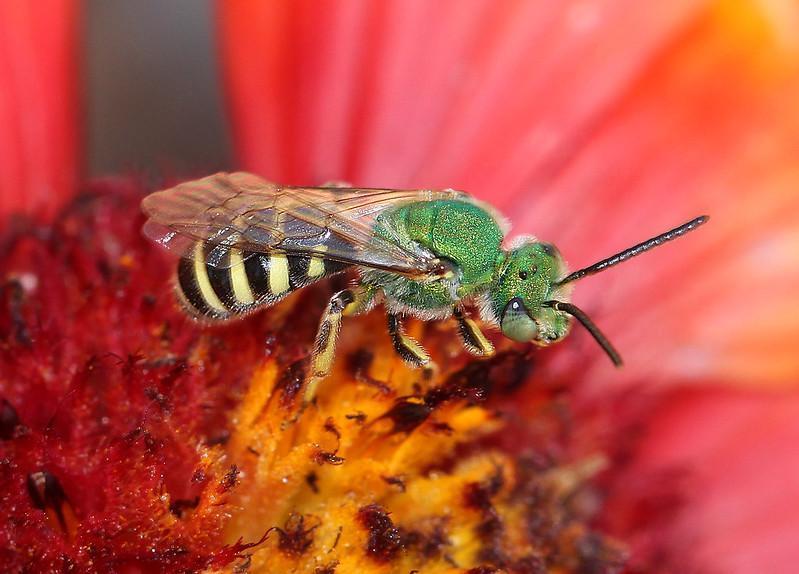
Experts usually do not recommend killing sweat bees as they are essential pollinators.
All these methods have their own pros and cons.
Repelling is the easiest and most humane way to get rid of sweat bees and keep them at bay when camping or working in a garden. All you have to do is put on some repellent on your skin, and you are good to go for a few hours.
Catching is a long-term solution for people who are unfortunate enough to share their homes or properties with sweat bees. It will reduce the number of sweat bees in your home and discourage them from returning to your place.
Lastly comes the killing. It is the permanent and most gruesome way of eliminating sweat bees in and around your home or property. However, experts usually do not recommend going this way as sweat bees are very important pollinators.
You should only kill sweat bees if:
- If you are allergic to bee stings, keeping them away is vital.
- If you work outdoors and sweat, bees hovering around you bother you.
- If they have nested on your property and are an ongoing concern.
Final Thoughts
Sweat bees are often allowed to persist in homes and gardens since they play a very fundamental role in pollinating crops and wildflowers. However, at times, they can become a nuisance and could even sting someone while they are outside.
So, you may want to get rid of them. However, if you decide to go that way, we recommend that you do not kill them but instead use some repellent to drive them away. It is because they are crucial pollinators and are pivotal for the environment.
Frequently Asked Questions (FAQs)
Can a sweat bee sting you?
Sweat bees usually live a solitary life and are not very aggressive. Therefore, the chances of you getting stung by one are extremely rare. However, like other bees, their stingers contain venom; if you are allergic, you need to be careful around them.
Why do they call them sweat bees?
Sweat bees are referred to as sweat bees because of their weird attraction to human sweat. These nuisance insects usually feed on pollen and nectar of plants. However, they also need salts which are rare to come by in nature. Therefore, sweat bees will occasionally feed on human sweat to supplement their diets.
Does sweat bee sting hurt?
When compared to the sting of other bees, the sweat bee sting is not very painful. In fact, many people do not even realize that they have been stung by a sweat bee unless they see a red swelling on their bodies.
However, sweat bee sting contains venom and could trigger severe allergic reactions in people who are allergic to bee venom.
Do sweat bees make honey?
No sweat bees do not make honey, and in fact, they do not even live in a bee hive. Instead, they make their nests in the ground or decaying wood and spend a solitary life.
Can a sweat bee sting you more than once?
Sweat bees can sting more than once as they can pull their stingers out of the skin after stinging someone once. It is only the honeybees that have specialized hooked stingers that remain, and the stinger gets torn away from the bee’s body as it flies away.
Sources for Further Reading
Honey Bees, Bumble Bees, Carpenter Bees, and Sweat Bees – Oklahoma State University. (2016). Retrieved 5 December 2022, from https://extension.okstate.edu/fact-sheets/honey-bees-bumble-bees-carpenter-bees-and-sweat-bees.html
Sweat bee study links genes to social behaviors, including autism | Department of Molecular Biology. (2022). Retrieved 5 December 2022, from https://molbio.princeton.edu/news/sweat-bee-study-links-genes-social-behaviors-including-autism
Obermeyer, J., Krupke, C., Long, E., Ingwell, L., Bledsoe, L., & Sadof, C. (2022). Sweat bee. Retrieved 5 December 2022, from https://extension.entm.purdue.edu/newsletters/pestandcrop/article-tags/sweat-bee/
Editor’s Recommendations
Black Caterpillar Types: How to Identify Common Species, Fun Facts and More!
Fungus Gnats in Houseplants & How to Identify and Effectively Control Them?
Are Japanese Beetle Traps Helpful for Organic Pest Management?







